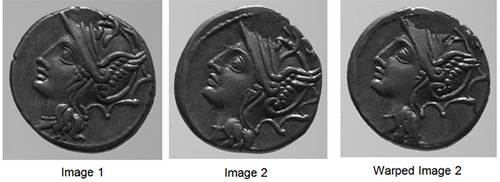
PREV ARTICLE
NEXT ARTICLE
FULL ISSUE
PREV FULL ISSUE
ILAC: IMAGE-BASED CLASSIFICATION OF ANCIENT COINS
A nice article in the latest Coins Weekly describes a computer-vision system being developed to help with
the cataloguing and processing of ancient coins.
-Editor

ILAC (Image-based classification of Ancient Coins) is an Austrian research project in the interdisciplinary field of computer vision together with numismatics. Numismatics can benefit greatly from the application of computer vision methods and in turn provides a large number of new, challenging and interesting conceptual problems and data for computer vision. The broad use of digital cameras has led to an exploding number of digitally recorded coins. While computers are extensively used for storing and working on numismatic data, no image based computer aided classification system for ancient coins has been developed so far. Since specialists are usually able to classify coins from 2D image information only, computer vision methods can be applied to coin images to support numismatists on the examination of coinages as well as to speed up the overall processes significantly. The classification system of ILAC will initially focus on gold and silver issues of the Roman Republican period, but its groundwork is applicable to every other period and can be filled with different sets of coin images, allowing further scientific challenges to be tackled in the future. Recent research for the image-based recognition of ancient coins was conducted during the EU funded predecessor project COINS, which lasted from February 2007 to January 2009. In COINS eight European partners aimed at developing effective measures to the fight against the illegal trade and theft of ancient coins. Besides the image-based recognition of coins, the project provided standardized inventories by defining a domain ontology, a multilingual thesaurus, data management tools and a specialized web search tool. The recognition of coins focused on the identification of their individual features that permit to classify it among the known features of the database. For this goal an identification method combing shape and die information of the coin was developed. It exploits the discriminative power of the boundary of ancient coins by applying shape matching algorithms as a pre-selection step. Afterwards, the dies of the remaining set are compared to the input image using local image features. The method achieved an identification rate of 98.83 % on a challenging dataset of 2400 coin images. In contrast to the COINS project, the ILAC project tries to answer a more interesting research question: Given an image showing an unknown coin, the goal is to develop a method that is able to automatically determine the coin type, based on different types in a database. This classificatory approach requires essentially different technologies: Identification (COINS) relies on individual, unique features, which make a specimen different from all other individuals in the same class, whereas classification (ILAC) emphasizes general class-specific features to assign an individual coin to a general category.
It's taken decades for the science and technology of computer vision and artificial intelligence to catch up to the promises dreamed up long ago. It's nice to see progress being made in the numismatic realm. With computers able to recognize faces and auto-tag uploaded photos of people, it may not be long before commercial systems can make initial attempts to attribute or grade coins based on an image alone.
-Editor
To read the complete article, see:
ILAC - new computer applications for numismatics
(www.coinsweekly.com/en/News/4?&id=1012)
The Numismatic Bibliomania Society is a non-profit organization promoting numismatic literature. See our web site at coinbooks.org. To submit items for publication in The E-Sylum, write to the Editor at this address: whomren@gmail.com To subscribe go to: https://my.binhost.com/lists/listinfo/esylum All Rights Reserved. NBS Home Page Contact the NBS webmaster 
|